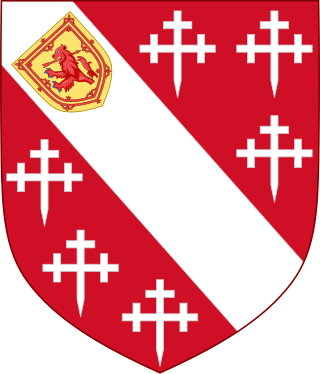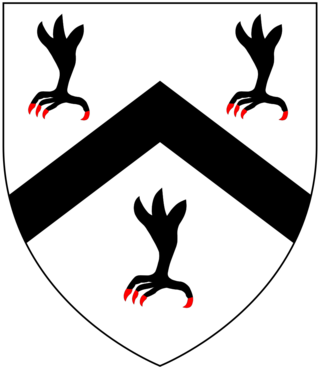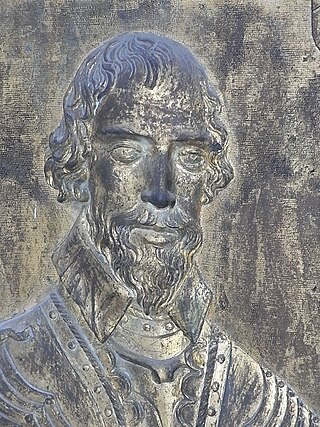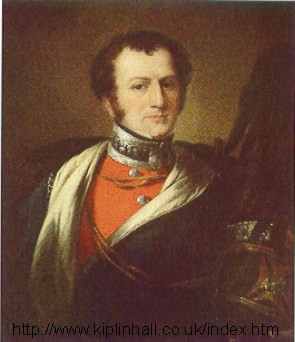
The House of Howard is an English noble house founded by John Howard, who was created Duke of Norfolk by King Richard III of England in 1483. However, John was also the eldest grandson of the 1st Duke of the first creation. The Howards have been part of the peerage since the 15th century and remain both the Premier Dukes and Earls of the Realm in the Peerage of England, acting as Earl Marshal of England. After the English Reformation, many Howards remained steadfast in their Catholic faith as the most high-profile recusant family; two members, Philip Howard, 13th Earl of Arundel, and William Howard, 1st Viscount Stafford, are regarded as martyrs: a saint and a blessed respectively.

Thomas Manners, 1st Earl of Rutland, 12th Baron de Ros of Helmsley, KG, of Belvoir Castle in Leicestershire, was created Earl of Rutland by King Henry VIII in 1525.

William Herbert, 1st Earl of Pembroke, 1st Baron Herbert of CardiffKG PC was a Tudor period nobleman, politician, and courtier.

In heraldry, impalement is a form of heraldic combination or marshalling of two coats of arms side by side in one divided heraldic shield or escutcheon to denote a union, most often that of a husband and wife, but also for unions of ecclesiastical, academic/civic and mystical natures. An impaled shield is bisected "in pale", that is by a vertical line.

Beaupré Hall was a large 16th-century house mainly of brick, which was built by the Beaupres in Outwell, Norfolk, England and enlarged by their successors the Bells. Like many of Britain's country houses it was demolished in the mid-20th century.

The Bishop of Hereford is the ordinary of the Church of England Diocese of Hereford in the Province of Canterbury.

Mary Fiennes, Baroness Dacre was the daughter of George Neville, 5th Baron Bergavenny by his third wife, Lady Mary Stafford, youngest daughter of Edward Stafford, 3rd Duke of Buckingham.

Edmund Braye, 1st Baron Braye, of Eaton Bray in Bedfordshire, was an English peer.

Sir John Wyndham, JP, of Orchard Wyndham in the parish of Watchet in Somerset, was an English landowner who played an important role in the establishment of defence organisation in the West Country against the threat of Spanish invasion.
The Baronetcy of Goodricke of Ribston was created in the Baronetage of England by King Charles I on 14 August 1641 for his loyal supporter John Goodricke of Ribston, Yorkshire. He represented Yorkshire in the Cavalier Parliament from 1661 to his death.

John Delaval Carpenter, 4th Earl of Tyrconnell GCH, FRS was a British peer. He served with the North York Corps of Yeomanry.

A number of cross symbols were developed for the purpose of the emerging system of heraldry, which appeared in Western Europe in about 1200. This tradition is partly in the use of the Christian cross an emblem from the 11th century, and increasingly during the age of the Crusades. Many cross variants were developed in the classical tradition of heraldry during the late medieval and early modern periods. Heraldic crosses are inherited in modern iconographic traditions and are used in numerous national flags.

Richard Fortescue of Filleigh, North Devon was an English Member of Parliament and prominent land-owner and member of the Devonshire gentry, ancestor to the Earls Fortescue.
Bassingbourne Gawdy, of West Harling, Norfolk, was an English landowner, magistrate and Member of Parliament (MP).

Hall is a large estate within the parish and former manor of Bishop's Tawton, Devon. It was for several centuries the seat of a younger branch of the prominent and ancient North Devon family of Chichester of Raleigh, near Barnstaple. The mansion house is situated about 2 miles south-east of the village of Bishop's Tawton and 4 miles south-east of Barnstaple, and sits on a south facing slope of the valley of the River Taw, overlooking the river towards the village of Atherington. The house and about 2,500 acres of surrounding land continues today to be owned and occupied by descendants, via a female line, of the Chichester family. The present Grade II* listed neo-Jacobean house was built by Robert Chichester between 1844 and 1847 and replaced an earlier building. Near the house to the south at the crossroads of Herner the Chichester family erected in the 1880s a private chapel of ease which contains mediaeval woodwork saved from the demolished Old Guildhall in Barnstaple.
Richard Southwell was a 15th-century British administrator from Norfolk. He was a Marshal of the Exchequer and an administrator for the Duke of Norfolk.

Richard Bampfield (1526–1594) of Poltimore and Bampfylde House in Exeter, both in Devon, was Sheriff of Devon in 1576. He began construction of the Tudor era Poltimore House in 1550, and completed the building of Bampfylde House, Exeter, along with The Great House, Bristol one of the finest Elizabethan townhouses in the West Country, in 1590. He is the ancestor of the Bampfylde Baronets and Barons Poltimore.

Sir Clement Smith, son of Thomas Smith of Rivenhall, Essex, and Isabel, daughter of William Foster of Little Baddow, Essex, served as an administrator in the reign of Henry VIII and Edward VI. He was Lord Treasurer's Remembrancer in the Exchequer, and was twice MP for Maldon in Essex, in 1545 and 1547. He was knighted by Edward VI on 22 February 1547.
Philip Gawdy was an English landowner and letter writer. There are extensive archives of the Gawdy family.

Sir Thomas Le Strange (1494–1545) of Hunstanton, Norfolk, born in 1494, son of Robert le Strange, sixth in descent from Hamo le Strange, brother of John le Strange, 6th Baron of Knockyn, was Esquire of the Body to Henry VIII, and attended the King when he went to the Field of the Cloth of Gold in 1520; he was knighted by Henry at Whitehall in 1529, and served as High Sheriff of Norfolk in 1532. Extracts from the Household Accounts kept at Hunstanton in the time of Sir Thomas and his successor, from 1519 to 1578, were published in the Archæologia for 1833. Sir Thomas was in attendance on Anne Boleyn at her coronation in 1533, her father, Sir Thomas Boleyn, being a Norfolk neighbour, who is mentioned repeatedly in the above accounts as a visitor at Hunstanton. In 1536 Sir Thomas Le Strange was appointed to attend on the King's person during the Pilgrimage of Grace, and to bring fifty men with him; in July of that year, he was placed on the commission to inquire into the revenues of the wealthy abbey of Walsingham, near his own Norfolk estate. It is to his credit that, though a personal friend of the King, and employed on business connected with the Dissolution of the Monasteries, Sir Thomas does not appear to have used his influence at court to secure for himself any church lands whatever. His picture, by Holbein, hung at Hunstanton Hall in 1893, according to his descendant Hamon le Strange, and a pencil sketch of him is among the Holbein drawings at Windsor; both these were exhibited at the Tudor Exhibition in 1890.
















